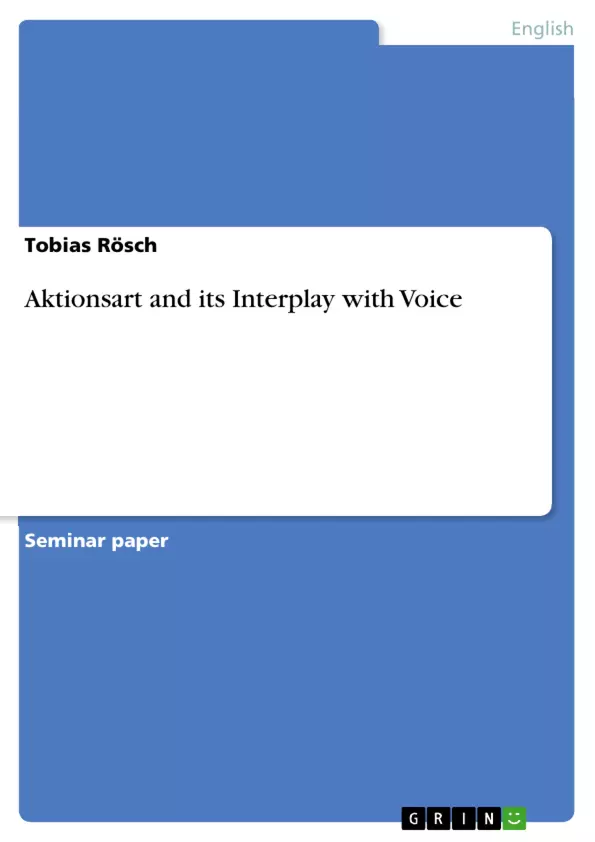The present paper is concerned with the interfaces between the verbal categories of aktionsart and voice. Despite the fact that aktionsarten have been known since antiquity, there still seems to be a certain amount of both terminological and conceptual confusion with respect to aktionsarten. A general definition most linguists can agree on involves the notion that aktionsart (which in most publications is referred to as lexical aspect) basically represents an immanent property of the verb assigning temporal information to a given lexical item. Lexical aspect differs from grammatical aspect in that it is restricted to verb semantics; neither does it include subdivisions based on conjugated forms of a verb, nor does it take into account the syntactico-semantic processes found on the sentential level.
Table of Contents
- Aktionsart and its Interplay with Voice
- Introduction
- Aktionsart: Basic Concepts and Types
- Voice and its Impact on Aktionsart
- The Role of Complements in Determining Aktionsart
- Passive Morphology and its Semantic Consequences
- Conclusion
Objectives and Key Themes
This paper examines the relationship between the linguistic categories of aktionsart (lexical aspect) and voice. The main objective is to analyze how these categories interact and influence the interpretation of verb phrases in English. The paper explores how different aktionsart types affect the use of voice, and how grammatical features like the passive voice influence the expression of temporal and aspectual meanings. Key themes addressed include:- Defining and classifying aktionsart types (activity, accomplishment, achievement, state)
- The role of complements in determining the telicity of a verb phrase
- The impact of passive morphology on verb phrase semantics
- Analyzing the interplay of aktionsart and voice in English sentences
- Distinguishing between stative and dynamic passive sentences
Chapter Summaries
This section focuses on summarizing the main themes and arguments presented in each chapter. It excludes summaries of the conclusion and any sections containing major revelations or spoilers.Introduction
This chapter introduces the topic of aktionsart and its interplay with voice in English. It defines aktionsart as a lexical aspect that represents an immanent property of verbs, assigning temporal information. It also outlines the difference between lexical and grammatical aspect.Aktionsart: Basic Concepts and Types
This chapter discusses the fundamental concepts and types of aktionsart. It outlines Vendler's classification of verbs into four categories: activity, accomplishment, achievement, and state. The chapter also introduces key distinctions like telicity and boundedness, exploring how they relate to the different aktionsart types.Voice and its Impact on Aktionsart
This chapter delves into the relationship between voice and aktionsart. It examines how the passive voice influences the interpretation of verb phrases and the expression of temporal and aspectual meanings. The chapter analyzes how the passive construction can alter the aktionsart of a verb, and how it relates to the presence of a by-phrase.The Role of Complements in Determining Aktionsart
This chapter explores how complements contribute to the determination of a verb phrase's aktionsart. It discusses how complements like "specified quantities of A" (SQA) can add a terminative meaning to the verb phrase, transforming a durative activity into a telic one.Passive Morphology and its Semantic Consequences
This chapter examines the semantic consequences of passive morphology. It focuses on the differences between stative and dynamic passive sentences, and how the auxiliary "be" can be used in both auxiliary and main verb roles.Keywords
The primary keywords and concepts explored in this paper include aktionsart, lexical aspect, voice, telicity, boundedness, activity, accomplishment, achievement, state, passive voice, complements, stative, dynamic, specified quantity of A (SQA), and by-phrase.- Citation du texte
- Tobias Rösch (Auteur), 2008, Aktionsart and its Interplay with Voice, Munich, GRIN Verlag, https://www.grin.com/document/140267




